|
|
|
Sort Order |
|
|
|
Items / Page
|
|
|
|
|
|
|
| Srl | Item |
| 1 |
ID:
134985
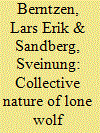

|
|
|
|
|
| Summary/Abstract |
Anders Behring Breivik, a lone wolf terrorist, killed 77 people in two terrorist attacks in Norway in 2011. This study uses framing theory from social movement studies to compare his Manifesto with the rhetoric of the anti-Islamic movement that inspired him. The anti-Islamic movement has a dual, and sometimes inconsistent, collective action framing. On the one hand, they portray Islam as an existential threat to the West and a warlike enemy; on the other, they promote peaceful and democratic opposition. The potential for radicalization is thus immanent. This case study reveals the importance of seeing lone wolf terrorists as acting from rhetoric embedded in larger social movements. It further demonstrates, in detail, the subtle and complex ways in which political narratives rejecting terrorism and political violence still end up inspiring such acts.
|
|
|
|
|
|
|
|
|
|
|
|
|
|
|
|
| 2 |
ID:
134984
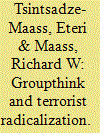

|
|
|
|
|
| Summary/Abstract |
Why do groups adopt terrorism? Major theories of terrorist radicalization assume it to be a rational process whereby groups select terrorism as the policy most likely to advance their goals. Not all terrorism is rational, however, and these theories cannot explain cases when groups pursue terrorism despite it being self-defeating. We distinguish between rational and irrational terrorism, and explain the latter using social psychology's groupthink mechanism. Although terrorists are widely assumed to be vulnerable to groupthink, empirical work on the phenomenon has focused overwhelmingly on decision-making by national executives. We firmly establish the link between groupthink and terrorist radicalization by tracing groupthink's operation through the development of the Weather Underground, an American terrorist group that emerged in the late 1960s and conducted six years of bombings against the U.S. government. All of the antecedent conditions, symptoms, and decision-making defects predicted by groupthink are evident in the Weather Underground, providing valuable evidence of the dangers of irrational radicalization and offering lessons for its prevention.
|
|
|
|
|
|
|
|
|
|
|
|
|
|
|
|
| 3 |
ID:
134986
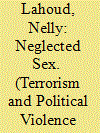

|
|
|
|
|
| Summary/Abstract |
The ideological literature of jihad excludes women from combat, even though the classical doctrine of defensive jihad (jihad al-daf’) that jihadis invoke stipulates that all Muslims—men, women, children, and slaves—have an obligation to go out to fight (fard ‘ayn) in defense of their territory and their faith. Thus, the validity of the doctrine of defensive jihad is inherently linked to its universal application to all Muslims. Jihadi ideologues and leaders, however, have either purposely refrained from calling on women to make their presence felt on the battlefield as warriors or have explicitly excluded them. This article is an investigation into this lacuna in jihadi ideology. It addresses a dimension that is hardly, if ever, discussed in the academic literature, namely the jihadis’ exclusion of women from combat. This exclusion represents a gaping hole in jihadi ideology and undermines the validity of the jihadis’ defensive jihad.
|
|
|
|
|
|
|
|
|
|
|
|
|
|
|
|
| 4 |
ID:
134992
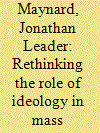

|
|
|
|
|
| Summary/Abstract |
There is a widespread sense amongst theorists of genocide and other violent atrocities that ideology matters. But in spite of this agreement all is not well with actual efforts to theorise ideology's role. Theoretical and empirical coverage has been uneven, and there has been little if any effort to incorporate theories and research from the actual specialist field of contemporary ideology studies. As a result, overarching theoretical accounts of the role ideology plays in violent atrocities remain limited and problematic. This article aims to encourage theorists to think about ideology in a more systematic and productive fashion by analysing four questions: (a) what do we mean by ideology?; (b) who, in cases of atrocity, might be relevantly affected by ideology?; (c) how do these people come to be influenced by atrocity-justifying ideologies?; and (d) how might ideology encourage these people to commit, or permit, mass violence? In discussing these four questions, I aim to clear up a number of misconceptions or vagaries that frequent current analyses of ideology in works on atrocity and political violence. I ultimately offer a suggestive account of six recurring “justificatory mechanisms” which collectively describe some of the common features of ideology's role across cases of mass atrocity.
|
|
|
|
|
|
|
|
|
|
|
|
|
|
|
|
| 5 |
ID:
134991
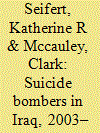

|
|
|
|
|
| Summary/Abstract |
Extending data reported by Mohammed Hafez in 2007, we compiled a database of 1,779 suicide bombers who attempted or completed attacks in Iraq from 2003 through 2010. From 2003 through 2006, monthly totals of suicide bombers show a pattern different from the pattern of non-suicide insurgent attacks, but from 2007 through 2010 the two patterns were similar. This biphasic pattern indicates that suicide attacks sometimes warrant separate analysis but sometimes are just one tactic in a larger envelope of insurgent violence. We also show that only 13 percent of suicide bombers targeted coalition forces and international civilians, primarily during the early years of the conflict, whereas 83 percent of suicide bombers targeted Iraqis (civilians, members of the Anbar Awakening Movement, Iraqi security forces, and government entities) in attacks that extended throughout the duration of the insurgency. These results challenge the idea that suicide attacks are primarily a nationalist response to foreign occupation, and caution that “smart bombs” may be more often sent against soft targets than hard targets. More generally, our results indicate that suicide attacks must be disaggregated by target in order to understand these attacks as the expression of different insurgent priorities at different times.
|
|
|
|
|
|
|
|
|
|
|
|
|
|
|
|
|
|
|
|
|